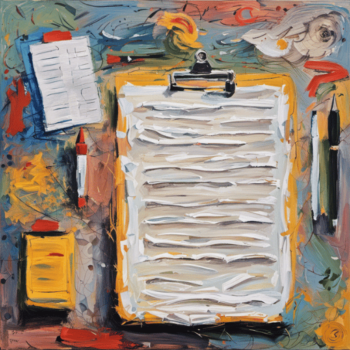Literary Editor SOPs
Creating Standard Operating Procedures for your Literary Editor work can be difficult and take time. That’s why we’ve created these example Literary Editor SOPs so you can jumpstart your SOP creation process. We want to help you set up your Writing/Editing systems and processes by taking these sample SOPs and building out your own SOPs template library. By having all your Writing/Editing procedures in one place, your team will have the information they need at all times. Let’s look at some Literary Editor SOP examples.
Literary Editor SOP Examples
1. Manuscript Evaluation SOP: The purpose of this SOP is to outline the process of evaluating manuscripts received by the literary editor. It includes guidelines for assessing the quality, marketability, and potential of the manuscript. The scope of this SOP covers the initial review and feedback provided to the author. The literary editor is responsible for conducting the evaluation and providing recommendations for further action. This SOP references the Manuscript Submission SOP for instructions on receiving and logging manuscripts.
2. Copyediting SOP: The Copyediting SOP details the procedures for reviewing and correcting grammar, spelling, punctuation, and style errors in a manuscript. The purpose of this SOP is to ensure that the manuscript is polished and adheres to the publishing industry’s standards. The scope of this SOP covers the entire manuscript, including text, headings, and captions. The literary editor is responsible for performing the copyediting, and this SOP references the Proofreading SOP for the final review process.
3. Developmental Editing SOP: The Developmental Editing SOP outlines the steps involved in providing substantive feedback and guidance to authors to improve the overall structure, plot, character development, and pacing of their manuscripts. The purpose of this SOP is to enhance the quality and marketability of the work. The scope of this SOP includes in-depth analysis and suggestions for revisions. The literary editor is responsible for conducting the developmental editing, and this SOP references the Manuscript Evaluation SOP for initial assessment and the Copyediting SOP for subsequent editing stages.
4. Proofreading SOP: The Proofreading SOP defines the procedures for conducting a final review of the manuscript to identify and correct any remaining errors or inconsistencies. The purpose of this SOP is to ensure the manuscript is error-free and ready for publication. The scope of this SOP covers the entire manuscript, including text, formatting, and layout. The literary editor is responsible for performing the proofreading, and this SOP references the Copyediting SOP for earlier editing stages.
5. Style Guide SOP: The Style Guide SOP establishes the guidelines and rules for maintaining consistency in writing style, formatting, and citation methods throughout the publishing process. The purpose of this SOP is to ensure a cohesive and professional presentation of the manuscript. The scope of this SOP covers all aspects of writing, including grammar, punctuation, capitalization, and citation styles. The literary editor is responsible for creating and updating the style guide, and this SOP references the Copyediting SOP for implementing style corrections.
6. Author Communication SOP: The Author Communication SOP outlines the procedures for maintaining effective and professional communication with authors throughout the editing process. The purpose of this SOP is to ensure clear and timely exchange of information, feedback, and updates. The scope of this SOP covers all interactions with authors, including initial manuscript acceptance, feedback delivery, and revision requests. The literary editor is responsible for managing author communication, and this SOP references the Manuscript Evaluation SOP for initial acceptance criteria.
7. Publication Guidelines SOP: The Publication Guidelines SOP provides instructions for preparing the manuscript for publication, including formatting, layout, and file requirements. The purpose of this SOP is to ensure the manuscript meets the publishing industry’s standards and is ready for printing or digital distribution. The scope of this SOP covers the final stages of manuscript preparation. The literary editor is responsible for overseeing the adherence to publication guidelines, and this SOP references the Proofreading SOP for the final review before publication.
8. Copyright and Permissions SOP: The Copyright and Permissions SOP outlines the procedures for obtaining necessary permissions and ensuring compliance with copyright laws when using copyrighted material within the manuscript. The purpose of this SOP is to protect the author and publisher from legal issues related to copyright infringement. The scope of this SOP covers the identification of copyrighted material, obtaining permissions, and documenting the necessary information. The literary editor is responsible for overseeing copyright and permissions, and this SOP references the Publication Guidelines SOP for proper citation and attribution.
9. Editorial Meeting SOP: The Editorial Meeting SOP defines the procedures for conducting regular editorial meetings to discuss ongoing projects, address challenges, and make decisions regarding manuscript selection, editing strategies, and publication timelines. The purpose of this SOP is to foster collaboration and ensure effective project management. The scope of this SOP covers the coordination and communication among the editorial team. The literary editor is responsible for organizing and leading the editorial meetings, and this SOP references the Manuscript Evaluation SOP for discussing manuscript submissions.
10. Quality Assurance SOP: The Quality Assurance SOP outlines the procedures for conducting quality checks on edited manuscripts to ensure the accuracy and consistency of the editing work. The purpose of this SOP is to maintain high-quality standards and minimize errors. The scope of this SOP covers the review of edited manuscripts, comparing them against the editing guidelines and style guide. The literary editor is responsible for performing quality assurance checks, and this SOP references the Copyediting SOP and Proofreading SOP for the editing stages
Literary Editor SOP Templates
Looking for SOP templates for your Literary Editor work? We’ve got you covered. You can build out your company SOPs using the sample SOP information above (added to our template) or our team can put together a starter SOPs template based on your Literary Editor work. Get in touch if you’ve got questions about the quickest way to build out your Writing/Editing SOPs library.









